Strong pecs have both practical and aesthetic value, making them highly sought after. The question is, how do we get them? Many people believe that maximizing strength and muscle hypertrophy is best done through a serious commitment to the good old bench press. But when you don’t have access to barbells or want to change up your training, there are great exercises with dumbbells that can improve chest strength and size.
Save for improving strength performance in the barbell bench press, dumbbells are just as good as barbells for training your pectorals. They also offer a variety of different exercises to choose from that cannot be done with barbells.
In this article, we’ll cover how-to train the chest with dumbbells and give you an overview of our favorite exercises, which are: the dumbbell bench press, dumbbell push-ups, dumbbell crossovers, the incline dumbbell press, the dumbbell fly, the crush-grip dumbbell press, the 15-degree decline dumbbell press, and dumbbell pullovers.
We’ll also offer several exercises for different chest workouts – including for beginners, those looking to build strength, or trainees looking to achieve muscle hypertrophy.
More Chest Content on Barbell Medicine:
- Best Chest Workout without Equipment
- Best Cable Chest Exercises
- Best Inner Chest Exercises
- Best Upper Chest Exercises
- Best Lower Chest Exercises
- Best Chest and Biceps Workout
- Best Chest and Shoulder Workout
What are the Best Chest Exercises With Dumbbells?
- Dumbbell Bench Press: 3 to 4 sets of 6 to 10 repetitions.
- Dumbbell Push-up: 2 to 3 sets of as many repetitions as you can perform
- Incline Dumbbell Press: 2 to 4 sets of 6 to 10 repetitions.
- Dumbbell Fly: 2 to 4 sets of 10 to 15 repetitions.
- Crush Grip Dumbbell Press: 2 to 4 sets of 10 to 15 repetitions.
- 15-Degree Decline Dumbbell Press: 2-4 sets of 8-12 repetitions
- Dumbbell Pullover: 2-4 sets of 10-20 repetitions.
1. Dumbbell Bench Press
Much like the barbell bench press, a dumbbell bench press is great for improving pressing strength and driving growth of the chest muscles. The movement itself and the required range of motion are very similar to that of a barbell bench press, meaning that when we perform dumbbell bench presses, we train the same muscles, though with a bet less stability comparatively.
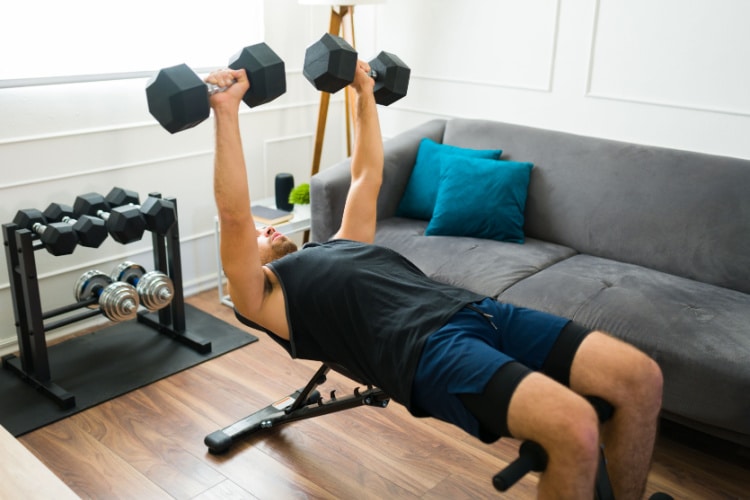
Movement Category: Secondary
Programming: 3 to 4 sets of 6 to 10 repetitions.
Weight: Use a weight that leaves you 2 to 3 reps short of failure, e.g., RPE 7 to 8.
To perform a dumbbell bench press:
- Pick up the dumbbells with your hands facing in and with a neutral grip.
- Sit on the bench with the dumbbells’ ends on your legs, inside your hip crease. Lay back and hold the weights on your chest.
- Once you’re ready, take a deep breath, and then press the dumbbells to lock out at the top. Lower the dumbbells slowly and with control until the dumbbells touch your chest.
- Push the dumbbells back up to the beginning position while contracting your chest.
2. Dumbbell Push-Up
It might seem unnecessary to use dumbbells for a simple bodyweight exercise. However, using the dumbbells to create a deficit allows for greater range of motion, thereby creating a more challenging version of the standard push-up. Think of this variation as a poor man’s parallette push-up, an excellent bodyweight choice for training the whole chest area. [1]

Movement Category: Tertiary
Programming: 2 to 3 sets of as many repetitions as you can perform to 1 to2 reps short of failure, e.g., RPE 8 to 9.
Weight: Bodyweight
To do a dumbbell push-up:
- Place two dumbbells on the floor, positioned at a shoulder-width distance apart.
- Start off by grabbing the dumbbells with your body in a push-up or tabletop position. You should be on your toes.
- Holding onto the dumbbells with a neutral grip, keep your core tight and your back straight similar to a normal plank position. This is your starting position
- Initiate the movement down by slightly rocking forward at the shoulder and bending your elbows, lowering your body slowly until your shoulders touch the top of the dumbbells.
- Push yourself up until your arms are fully straightened out. Make sure your back is straight, and your core is tight throughout the movement.
- Repeat the movement for the designated number of reps.
3. Incline Dumbbell Press
The angle of the bench press gets a lot of attention when it comes to discussing both muscle growth and strength development. Many studies have investigated the electrical activity, e.g., “excitation” of muscles like the anterior deltoid, pec major and other muscles during flat, incline, and decline bench press using surface electromyography (sEMG) with varying results. In general, the more vertical the angle of the bench is, the more anterior deltoid and upper pec are being loaded. The lower the angle of the bench, the less anterior deltoid and more pec are being used.
While sEMG differences using different bench angles don’t reliably predict actual outcomes, e.g., differences in muscle size and strength, the incline bench press using a barbell or dumbbells are both great exercises to train the chest. We recommend that you set your bench inclination to anywhere between 15 to 30 degrees.
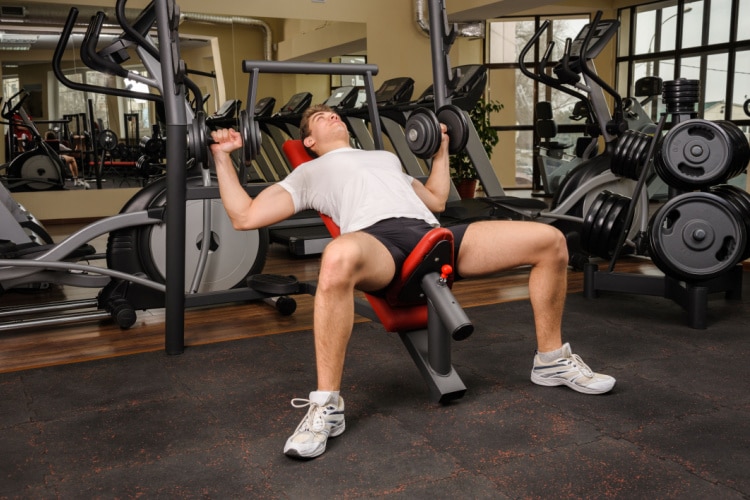
Movement Category: Secondary
Programming: 2 to 4 sets of 6 to 10 repetitions.
Weight: Use a weight that leaves you 2 to 3 reps short of failure, e.g., RPE 7 to 8.
To do an incline dumbbell press:
- Set the bench angle to anywhere between 15 to 30 degrees relative to the horizontal.
- Pick up the dumbbells and lie down on the bench. Your hands should be facing inwards and holding the dumbbells in a neutral grip. Lie down on the bench with the dumbbells in your hands.
- Using your legs for assistance, lift the dumbbells up to your chest. This is the bottom of the range of motion.
- In a smooth motion, press the dumbbells upwards off the chest until your elbows are fully extended.
- Lower the dumbbells back down to the starting position. Do the movement with as much control as possible.
4. Dumbbell Flyes
Dumbbell flyes are a killer chest-focused isolation exercise that will have you feeling the burn in the middle and inner chest area. This is a great finishing exercise to improve hypertrophy in the chest, which can be done on a flat or incline bench based on your preferences.
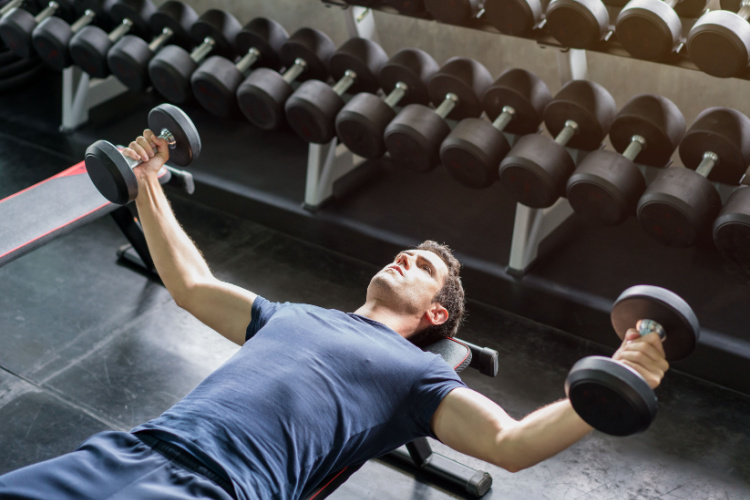
Movement Category: Tertiary
Programming: 2 to 4 sets of 10 to 15 repetitions.
Weight: Use a weight that leaves you 1 to 2 reps short of failure, e.g., RPE 8 to 9.
To do a dumbbell fly:
- Pick up a pair of dumbbells and sit on a flat or incline bench, placing the dumbbells on your thighs.
- Lie on your back on a flat or incline bench, placing your feet on the ground on either side. Using your legs for assistance, move the dumbbells to your chest and press them straight up, extending the elbows to a softly locked position.
- Make sure your palms and dumbbells face one another and that there’s a bit of a bend at your elbow. Keep your head and back pressed onto the bench during the entire activity.
- Under control, slowly lower the dumbbells out to your sides in an arc motion until they’re aligned with your chest. Your elbows shouldn’t bend or extend during the movement and your arms should end up about level with your chest and shoulders.
- Think about pulling the dumbbells “up” and “back together” to reverse the motion. The dumbbells should be directly above the shoulder joint at the top.
5. Crush Grip Dumbbell Press
As the name suggests, you’ll have to crush your pecs to execute a crush grip dumbbell press. It is an isometric exercise that mainly works the pecs, but also activates other muscles, such as the anterior deltoid, lateral deltoids, and triceps.
While going through this exercise, you won’t only have to deal with the resistance of the dumbbell load. There will also be the added resistance of pushing the dumbbells together at the top of your lift, making them a dumbbell press variation, which is particularly great for the triceps and inner chest area.
Ideally, you would do this exercise with hexagonal dumbbells that touch one another during the movement. If you don’t have access to a pair of hexagonal dumbbells, you could always use regular dumbbells that you press together.
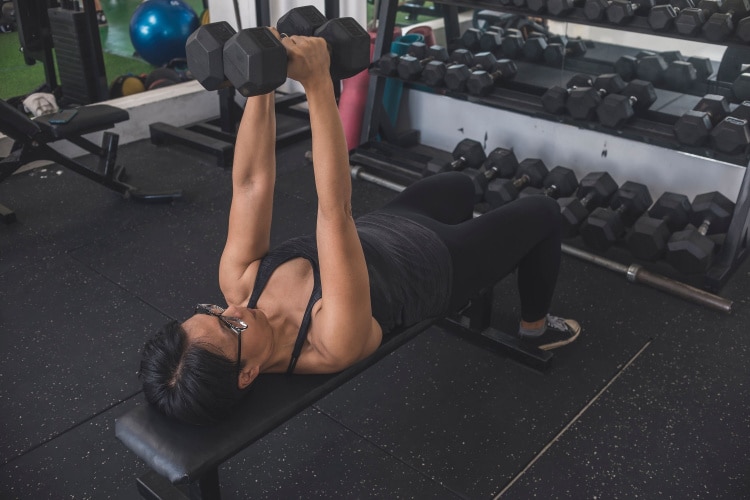
Movement Category: Tertiary
Programming: 2 to 4 sets of 10 to 15 repetitions.
Weight: Use a weight that leaves you 1 to 2 reps short of failure, e.g., RPE 8 to 9.
To do a crush grip dumbbell press:
- Sit on the end of a bench with a dumbbell in each hand.
- Roll back to lie down with control.
- Extend your arms as you lie back with both feet planted firmly on the ground.
- Hold up the dumbbells at an arm’s length away from your shoulders. Your palms should be facing one another and the sides of the dumbbells should be touching. This is your starting position.
- Engage your core, push the dumbbells together, and lower them down to your abdomen. Tuck your arms in slightly as you lower the weights.
- When the dumbbells touch your chest, start raising your arms back up to the starting position. Make sure the dumbbells are pressed together throughout the range of motion.
6. 15-Degree Decline Dumbbell Press
Similar to our discussion regarding the incline dumbbell bench press potentially training the anterior deltoid and upper pec “more” than a more horizontal bench variation, the decline dumbbell bench is likely to predominantly load the pectoralis major and its lower part. Whether this produces regional differences in hypertrophy compared to using a flat or incline bench is unknown, but we think training a muscle group at multiple angles is a good idea for overall development.
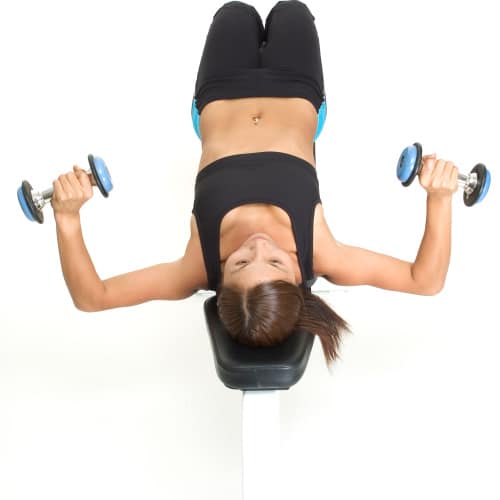
Movement Category: Tertiary
Programming: 2-4 sets of 8-12 repetitions
Weight: Use a weight that leaves you 2 to 3 reps short of failure, e.g. RPE 7 to 8.
To do a 15-degree decline dumbbell press:
- Set the bench incline to -15 degrees relative to the floor.
- Pick up the dumbbells and lie down on the bench. Your hands should be facing inwards and holding the dumbbells in a neutral grip. Lie down on the bench with the dumbbells in your hands. Most decline benches have a split pad to secure your legs against. Make sure you’re secure on the bench.
- Move the dumbbells back and down to touch your chest.. This is the bottom of the range of motion.
- In a smooth motion, press the dumbbells upwards off the chest until your elbows are fully extended.
- Lower the dumbbells back down to the starting position. Do the movement with as much control as possible.
7. Dumbbell Pullover
The dumbbell pullover isn’t just a great exercise for your lower pectorals, but also for the lower part of your upper body in general, hitting the latissimus dorsi and serratus anterior muscles as well. When executed appropriately, with the right amount of control, this exercise can truly fire up your chest.
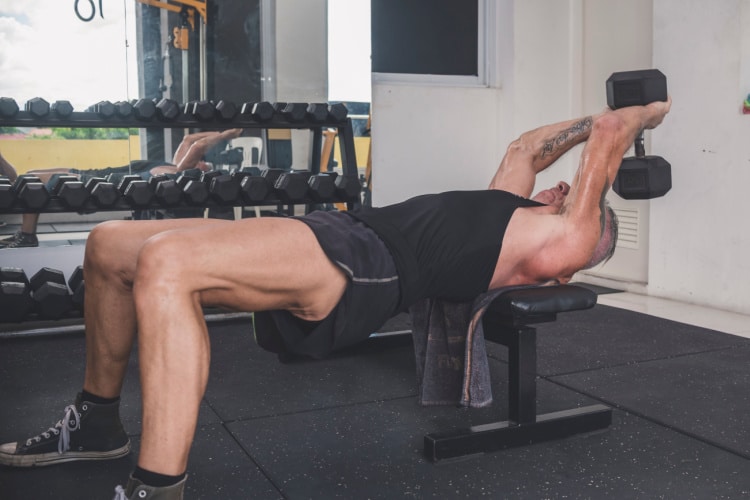
Movement Category: Tertiary
Programming: 2-4 sets of 10-20 repetitions
Weight: Use a weight that leaves you 1 to 2 reps short of failure, e.g. RPE 8 to 9.
To do a dumbbell pullover:
- Lie down on the bench with a slight arch in your back.
- Keep your feet flat on the ground and your knees bent at 90 degrees to ensure for stability
- Hold a single dumbbell with both hands, press the dumbbell up over the center of your chest. This is your starting position.
- Maintaining a slight bend at your elbow, lower the dumbbell back over your head in an arcing motion.
- Aim to get the dumbbell as close to the ground as possible. You should feel a deep stretch in your pecs and lats.
- Return to the starting position.
So, now that we’ve covered our favorite dumbbell chest exercises, let’s get into how you can combine them to tailor the best chest workout for you. Keep in mind that different individuals will have different needs according to their fitness level, lifting experience, and training goals. While expectations and needs could vary greatly from trainee to trainee, today, we’ll focus on three main groups of lifters — specifically beginners, those focused on strength, and those focused on hypertrophy, proposing a suitable chest workout for each.
How Can Beginners Train Their Chest with Dumbbells?
If you’re new to lifting and you’re looking to train your chest with dumbbells, we suggest you incorporate at least two to three chest exercises per workout with lighter weights. [2] If you have no background in weightlifting at all, you may find it difficult to gauge the weights of the dumbbells you should use.
Since you’re new to lifting, you’d have to train the chest and the other muscles in your body in a way that builds a wide range of physical skills and adaptations. To achieve this, we use a variety of repetition schemes and exercises that build strength, power, endurance, and muscle mass. We recommend against early specialization in the chest, which refers to gunning for maximum strength in a single repetition range of one or only few types of exercises. This is because early specialization increases the risk of injury and decreases long term gains in health and performance and health. [3, 4]
In terms of exercise dosing, the 2018 Physical Activity Guideline for Americans recommends doing strength-focused exercises twice a week, with 1-to-3 sets of 8-to-12 repetitions for each muscle group, and using a weight that gets the trainee within 1 repetition of failure. [5] Other data shows that this recommendation is better suited for older adults looking to enhance strength. Younger individuals, on the other hand, will require a higher number of sets per exercise, and a reduced number of repetitions per set, for instance, 5 sets of 6-to-8 repetitions per exercise. [6, 7]
The common recommendation to start at 2 to 3 sets per exercise may seem reasonable for beginners, but is actually not backed by any experimental evidence. On top of that, these general guidelines don’t offer much insight into the required number of exercises for a certain muscle group or movements per session or per week. Lastly, the recommendation to take each set 1 repetition short of failure is also not based on any evidence – it’s completely made up. In fact, recent data shows that strength and hypertrophy gains are similar when sets are done 4-to-5 repetitions short of failure. [8-11]
That being said, our suggested dumbbell chest workout for a beginner is:
- Flat Dumbbell Bench Press: 3 sets of 6-10 reps @ RPE 7-8
- Incline Dumbbell Bench Press: 2 sets of 8-12 reps @ RPE 7-8
- Dumbbell Flyes: 2 sets of 10-15 reps @ RPE 8-9
- Dumbbell Pullovers: 2 sets of 10-15 reps @ RPE 8-9
Dumbbell Chest Workout for Strength
If you’ve been lifting for at least six months, the beginner workout probably won’t cut it for you. We’d recommend prioritizing strength performance or hypertrophy at this point with the understanding that it’s not really one or the other. Rather, a good strength training program will generate some improvement in hypertrophy and a good hypertrophy program will produce an increase in strength. The main differences in outcomes are the size of the improvements, with the strength program producing relatively greater improvements in strength and vice versa for the hypertrophy-focused program.
If improving strength is your ultimate goal, then this is our recommendation:
- 4 sets of 5 to 8-repetitions @ RPE 7-8 of Dumbbell Flat Bench Press
- 4 sets of 5 to 8-repetitions @ RPE 7-8 of Dumbbell Incline Bench Press
- 3 sets to RPE 8-9 of Dumbbell Push-Ups
- 3 sets of 10-15 reps @ RPE 8-9 of Dumbbell Flyes
Alternatively, if you’re feeling weakness in any isolated muscle in your chest, you could try switching out either the dumbbell push-ups or the dumbbell pullovers for another exercise targeting the area you feel weakness in.
Dumbbell Chest Workout for Hypertrophy
Looking to grow the size of your chest? Here are some great chest exercises for hypertrophy:
- 4 sets of 6-10-repetitions @ RPE 7-8 of Dumbbell Incline Bench Press
- 4 sets of 8-12-repetitions @ RPE 7-8 of Dumbbell Decline Bench Press
- 4 sets of 10-15 reps @ RPE 8-9 of Dumbbell Flyes
- 3 sets of 10-15 reps @ RPE 8-9 of Dumbbell Pullovers
Keep in mind that we’ve provided additional exercises for each muscle group to help you switch them out when it comes time to change up your training. We recommend considering a change in exercises (if desired) and other training variables every 6 to 10 weeks or so.
How to Program Your Workout
One thing you’ll notice about exercising with dumbbells is the versatility that they offer. In contrast to training with barbells, where most of the movements you do are variations of the bench press, dumbbells offer a lot more variations like flyes, pullovers, and more. This is likely important for individuals who are training to get bigger, as training the muscle using different exercises, at different angles, using different, long range of motions are good principles to follow for muscle size.
As laid out above, hypertrophy-focused training is likely to have more volume, higher rep ranges, more isolation exercises, and have sets taken closer to failure. In contrast, strength-focused programs will use lower rep ranges, more compound exercises, and most sets are a bit further away from failure. The differences in weight used are determined by both the rep ranges and proximity to failure, with strength-focused programs using relatively heavier loads than hypertrophy-focused programs most of the time as a result.
What are the Benefits of Working Out Your Chest With Dumbbells?
Resistance training done with any type of equipment is similarly effective.While the bench press is the king of chest workouts, working out with dumbbells has its own advantages. They offer variety and are a valid alternative to barbells. To illustrate better, we’ve outlined a few of their benefits.
Better Range of Motion
Dumbbells are great equipment to use if you’re looking to work multiple muscle groups because training with them requires a great range of motion. [13] Plus, there’s a variety of exercises you can do with barbells that aren’t simply variations of the same movement.
Improved Stability
When we lift dumbbells, we often don’t have the support of our other hand as we do when we lift barbells. This makes controlling them inherently more difficult, but that’s where their beauty lies.
Dumbbells offer a bit more freedom than some other equipment, requiring the trainee to keep their form, which can, in turn, help improve stability, even with lighter loads. [14]
Safety in Training
Despite any gym-horror stories you may have heard, all types of resistance training, including workouts done with dumbbells and barbells, are relatively safe. In fact, the risk of injury with resistance training is so low that the average rate is only 1-4 injuries per 1,000 resistance training hours. [15-17] By comparison, cycling and walking have injury rates of roughly 0.5-2 injuries per 1,000 participation hours, implying that bodybuilding, powerlifting, weightlifting, and CrossFit have injury risks equivalent to other non-contact sports and recreational activities.
Note that we would not expect dumbbells to be inherently safer than barbells. They are simply another safe technique to lift weights.
Tips for Working Out With Dumbbells
Due to the versatility of the dumbbell, it may sometimes be difficult to gauge the correct way to use it, so we’ve provided some tips that can help lifters get a good head start.
Get Your Range of Motion Right
Dumbbells are often used as two separate pieces of equipment, but the range of motion is one complete movement. Try to use a long range of motion as discussed in the movement descriptions above.
Incorporate Appropriate Rest and Recovery Days
Rest and recovery are important for all trainees, as they allow muscles to recover and other adaptations to take place. One study showed that complete muscle recovery can only be achieved 72 hours after the muscle is damaged. However, that doesn’t mean we need to wait that long before another workout, as “complete muscle recovery” is not necessary in order to continue to increase fitness. [12]
Every training session (good or bad) generates both fitness and fatigue. Over time, a person gets used to the training load, getting better at not only tolerating the training, but also recovering from it. Over weeks and months, the relative amount of fatigue generated from a given training load tends to decrease, allowing for proportionally more fitness adaptations to be demonstrated. Improvements in fitness take place over a longer period of time than muscle recovery, as they are driven by the accumulation of stress from many training sessions, not “complete muscle recovery” within a few days of a single session.
How often you train is mainly dependent on your current fitness levels, goals, and resources. The 2018 Physical Activity Guidelines for Americans recommend performing muscle-strengthening exercises at least twice per week, which is a reasonable place to start for beginners. It is possible to train on consecutive days or non-consecutive days depending on your preferences, schedule, and training program.
Warm-Ups Are Important
No, we’re not talking about the conventional type of warm-ups such as doing cardio or stretching. While these could have their benefits, they don’t really prepare you for the task at hand- lifting weights in this case.
Instead, we suggest picking up dumbbells that are much lighter than what you usually train with and going through a few reps of the exercises before doing them with an actual load. This is a practice we refer to as warm-up sets, which serves as a “warm-up” of sorts, one that actually does improve the quality of your lifts. This will help your muscles get accustomed to the movement and range of motion before you have to do them for real.
Link Up With Barbell Medicine
The chest muscles are an important muscle group to focus on in order to gain both size and strength. So, when you’ve got a muscle group as large and essential as this, what do you do? Ask for the help of professionals, of course!
At Barbell Medicine, we offer evidence-based programs backed by the latest developments in sports science. If you’d like to follow a program that will help you grow and strengthen your chest, don’t hesitate to check our program templates.
If you’re not too keen on following pre-made templates and would like a more personalized approach, we also create personalized programs for our clients based on their current fitness levels and goals. Don’t hesitate to reach out to us to receive a training program made just for you.
References
- Allen, C.C., Dean, K.M., Jung, A.P., & Petrella, J.K. (2013). Upper Body Muscular Activation during Variations of Push-Ups in Healthy Men. International journal of exercise science, 6, 3.
- Murlasits, Z., Reed, J., & Wells, K. (2012). Effect of resistance training frequency on physiological adaptations in older adults. Journal of Exercise Science & Fitness, 10(1), 28-32. https://doi.org/10.1016/j.jesf.2012.04.006
- Ford, Paul et al. “The long-term athlete development model: physiological evidence and application.” Journal of sports sciences vol. 29,4 (2011): 389-402. doi:10.1080/02640414.2010.536849
- Post, Eric G et al. “The Association of Sport Specialization and Training Volume With Injury History in Youth Athletes.” The American journal of sports medicine vol. 45,6 (2017): 1405-1412. doi:10.1177/0363546517690848
- Piercy, Katrina L et al. “The Physical Activity Guidelines for Americans.” JAMA vol. 320,19 (2018): 2020-2028. doi:10.1001/jama.2018.14854
- Borde, Ron et al. “Dose-Response Relationships of Resistance Training in Healthy Old Adults: A Systematic Review and Meta-Analysis.” Sports medicine (Auckland, N.Z.) vol. 45,12 (2015): 1693-720. doi:10.1007/s40279-015-0385-9
- Lesinski, Melanie et al. “Effects and dose-response relationships of resistance training on physical performance in youth athletes: a systematic review and meta-analysis.” British journal of sports medicine vol. 50,13 (2016): 781-95. doi:10.1136/bjsports-2015-095497
- Aasa, U., Svartholm, I., Andersson, F., & Berglund, L. (2017). Injuries among weightlifters and powerlifters: a systematic review. British journal of sports medicine, 51(4), 211–219. https://doi.org/10.1136/bjsports-2016-096037
- Pareja-Blanco, Fernando et al. “Effects of Velocity Loss During Resistance Training on Performance in Professional Soccer Players.” International journal of sports physiology and performance vol. 12,4 (2017): 512-519. doi:10.1123/ijspp.2016-0170
- Pareja-Blanco, F et al. “Effects of velocity loss during resistance training on athletic performance, strength gains and muscle adaptations.” Scandinavian journal of medicine & science in sports vol. 27,7 (2017): 724-735. doi:10.1111/sms.12678
- Carroll, Kevin M et al. “Skeletal Muscle Fiber Adaptations Following Resistance Training Using Repetition Maximums or Relative Intensity.” Sports (Basel, Switzerland) vol. 7,7 169. 11 Jul. 2019, doi:10.3390/sports7070169
- McLester, J. R., Bishop, P. A., Smith, J., Wyers, L., Dale, B., Kozusko, J., Richardson, M., Nevett, M. E., & Lomax, R. (2003). A series of studies–a practical protocol for testing muscular endurance recovery. Journal of strength and conditioning research, 17(2), 259–273. https://doi.org/10.1519/1533-4287(2003)017<0259:asospp>2.0.co;2
- Solstad, T. E., Andersen, V., Shaw, M., Hoel, M., Vonheim, A., & Saeterbakken, A. (2020). A Comparison of Muscle Activation between Barbell Bench Press and Dumbbell Flyes in Resistance-Trained Males. Journal of Sports Science & Medicine, 19, 645-651.
- Saeterbakken, A., Tillaar, R., & Fimland, M. (2011). A comparison of muscle activity and 1-RM strength of three chest-press exercises with different stability requirements. Journal of Sports Sciences, 29, 533-538. doi:10.1080/02640414.2010.543916.
- Ford, Paul et al. “The long-term athlete development model: physiological evidence and application.” Journal of sports sciences vol. 29,4 (2011): 389-402. doi:10.1080/02640414.2010.536849
- Post, Eric G et al. “The Association of Sport Specialization and Training Volume With Injury History in Youth Athletes.” The American journal of sports medicine vol. 45,6 (2017): 1405-1412. doi:10.1177/0363546517690848
- Piercy, Katrina L et al. “The Physical Activity Guidelines for Americans.” JAMA vol. 320,19 (2018): 2020-2028. doi:10.1001/jama.2018.14854